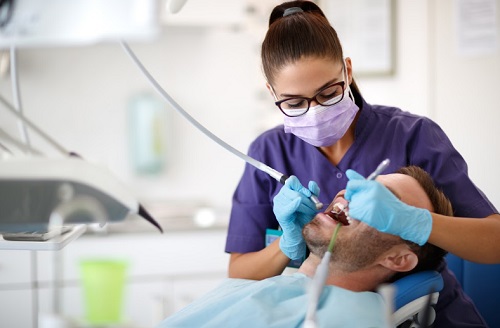Keeping a bright, healthy smile shouldn’t break the bank. While quality dental care can sometimes seem financially daunting, there are strategies to manage costs effectively without sacrificing the quality of treatments. Understanding the system, exploring all available options, and making intelligent decisions can help you cut costs for keeping your teeth in shape.
With that in mind, here are six secrets that can help reduce dental care and treatment costs.Â
1. Consider All-On-4-CostsÂ
The All-on-4 treatment is an advanced dental implant procedure that replaces missing teeth with a full dental bridge, supported by only four dental implants. While the upfront cost may seem daunting, it’s essential to consider the long-term benefits and savings.Â
Initial All-on-4 costs may be higher than traditional methods like dentures or bridges. However, the value becomes evident when you factor in durability, comfort, and low maintenance. Unlike dentures requiring regular replacement, All-on-4 is a one-time investment providing a permanent solution.Â
Moreover, the ongoing costs of maintaining traditional dentures—including unique cleaning solutions, adhesives, and periodic adjustments or replacements—increase over time. These expenses are almost nonexistent with All-on-4 implants, making them a cost-effective solution in the long run.Â
2. Embrace TechnologyÂ
In the era of digital advancements, the dental industry is not lagging behind. Embracing technology can help significantly reduce dental care and treatment costs. For instance, teledentistry allows patients to consult with dentists remotely, reducing the costs of in-person visits.Â
Another innovative technology is 3D printing, which is revolutionizing the production of dental appliances like crowns, bridges, and aligners. These tools can be made quickly and accurately, often cheaper than traditional manufacturing methods.Â
Moreover, digital X-rays and imaging provide precise diagnoses, reducing the likelihood of unnecessary procedures. Artificial intelligence also contributes to predictive analytics, identifying potential problems early and saving costs associated with complex processes later. Â
3. Be Proactive With Preventive CareÂ
Taking a proactive stance on preventive dental care is one of the most effective ways to control treatment costs. This strategy hinges on the principle that addressing minor issues earlier prevents them from becoming major, costly problems in the future. Regular dental check-ups, for example, can help identify potential problems like the onset of cavities or gum diseases, which can be tackled promptly with less invasive and less expensive treatments.Â
Adopting a diligent at-home oral hygiene regimen is equally important. Daily brushing, flossing, and use of mouthwash can drastically reduce the risk of decay and gum disease. Incorporating a healthy diet that is low in sugar also plays a significant role in preventing dental issues.Â
Additionally, preventive measures like dental sealants or fluoride treatments can be beneficial, particularly for children. They may involve high upfront costs but can save a lot in future restorative procedures. Therefore, prioritizing preventive care is an investment that pays off significantly in the long run.Â
4. Go For Dental Discount PlansÂ
Dental discounts or dental savings plans are an alternative way to reduce dental care costs. They are not insurance plans but membership programs that provide significant discounts on various dental procedures. You pay an annual membership fee and get access to reduced rates from participating dentists.Â
These plans can supplement your existing dental insurance, especially for procedures that aren’t fully covered, like cosmetic dentistry. They can also be a lifesaver for those without dental insurance, providing access to affordable dental care.Â
5. Consider Dental SchoolsÂ
Dental schools offer services performed by students under the direct supervision of experienced dental educators, and these services typically come at a fraction of the cost compared to regular dental offices.Â
These students are well-trained, up-to-date with the latest techniques, and closely supervised, ensuring a high standard of care. Dental schools can provide various treatments, from essential cleaning and fillings to more complex procedures like root canals and crowns.Â
Dental schools often have access to advanced technology, which may not be available in all private practices. This ensures that you’re getting affordable care and benefiting from cutting-edge technology and treatments.Â
However, one downside is that procedures at dental schools may take longer due to the educational process involved. But if time is not a constraint, dental schools are a cost-effective option for quality dental care.Â
6. Opt For In-Network Dentists
Choosing in-network dentists is another significant way to lower your dental care expenses. These dentists have contractually agreed with your dental insurance provider to charge lower rates for the covered procedures. By opting for in-network dentists, you can ensure you’re getting your treatments at these discounted rates.
This strategy reduces out-of-pocket expenses and prevents ‘balance billing,’ where you might be charged for the difference between the dentist’s fee and the insurance company’s allowed amount. Remember, out-of-network dentists are under no obligation to limit their fees. Therefore, sticking to in-network providers can make a significant difference in your overall dental treatment costs while ensuring you get quality care.
ConclusionÂ
Finding ways to minimize costs without compromising quality is crucial in dental care. The strategies outlined above aid in cost reduction and ensure you receive top-notch care. From being proactive with preventive measures to considering alternatives like dental discount plans and dental schools, there’s a spectrum of options to explore. Â
Assessing long-term perspectives like All-on-4 costs and embracing the role of technology can also provide significant savings. Ultimately, each decision should be grounded in research, professional advice, and personal comfort, as oral health is integral to overall well-being, deserving both attention and investment.Â



















